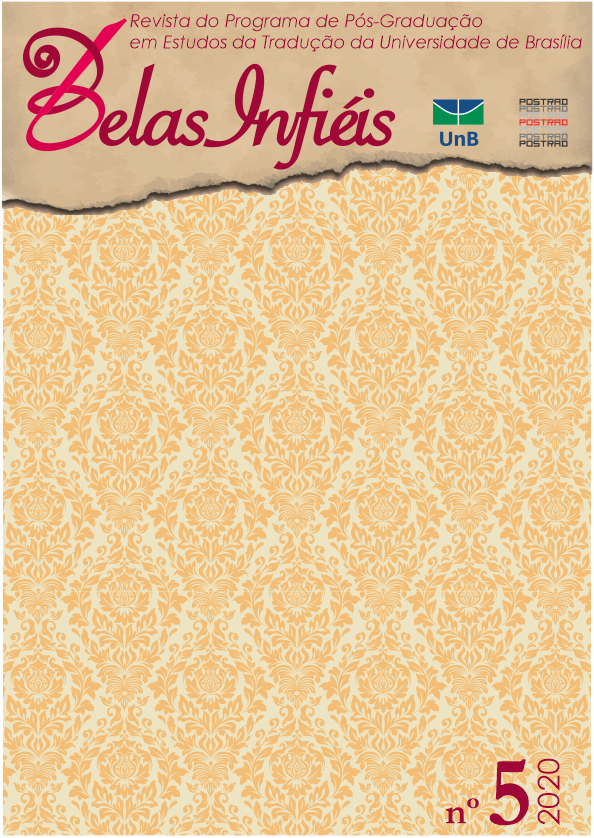A Libras Relationship with a Functional Systemic Linguistic (LSF): an analysis of images of signs based on the variables of the Context of situation
DOI:
https://doi.org/10.26512/belasinfieis.v9.n5.2020.29368Keywords:
Interpretation. Libras. Functional Systemic Linguistic.Abstract
This study aimed to contribute to the understanding of the uses and the importance of the visual language ”“ LIBRAS ”” Língua Brasileira de Sinais, in social spaces. With a theoretical framework from Systemic-Funcional Linguistics (SFL), Halliday (2004 [1994]), and in Deaf Studies, Brito (1993), Quadros (2004), and Translation Studies, Pagura (2003), and others. Being it about a theoretical and methodological support that investigates the social use of language, SFL is important to illustrate the relevance in maintaining a television network channel using a visual language with simultaneous interpretation as a means of accessibility by deaf people. The analysis occurred in a piece of television show named Visual News that is signed and is available on YouTube. The analysis done regarded only 30 seconds of the news calls taking into consideration the concept from SFL context of situation that comprises three variables: field/area of speech, tenor, and mode. This brief study aimed at showing the relevance of studies based on Halliday’s SFL by involving two languages of a distinct nature, though not least important. We hope this analysis can raise a critical look in readers regarding the context of situation of a TV program. Hence, this is the importance of knowing how the variables of the context of situation work.
Downloads
References
AUBERT, Francis Henrik. Modalidades de tradução: teoria e resultados. TradTerm, 5(1), p. 99-128, 1º Semestre de 1998.
BRITO, Lucinda F. Integração social & Educação de surdos. Rio de Janeiro: Babel, 1993.
CARVALHO, Márcia M.; ARAÚJO, Marília do Socorro O. O desafio da tradução entre Língua portuguesa e Libras diante do fenômeno da sinonímia. Cadernos de Tradução. Florianópolis, v. 37, n. 2, p. 208-228, mai-ago, 2017. Disponível em: https://periodicos.ufsc.br/index.php/traducao/article/view/2175-7968.2017v37n2p208. Acesso em: 3 set. 2020.
CARVALHO, Márcia M. Avaliação da compreensão escrita de alunos surdos do ensino fundamental maior. 102 f. Dissertação (Mestrado). Programa de Pós-graduação em Letras, Universidade Federal do Pará, Belém, 2012. Disponível em: https://repositorio.ufsc.br/handle/123456789/190924. Acesso em: 3 set. 2020.
EGGINS, Suzanne. An introduction to Systemic Functional Linguistics. London: Pinter, 1994.
FARIA, Evangelina Maria Brito de; ASSIS, Maria Cristina de (org.). Língua portuguesa e LIBRAS: teorias e práticas 4. João Pessoa: Editora Universitária da UFPB, 2011.
FUZER, Cristiane, CABRAL, Regina Scotta. Introdução à gramática sistêmico-funcional em Língua Portuguesa. 1. ed. Campinas, SP: Mercado das letras, 2014.
GOUVEIA, Carlos A.M. Textos, análises e interpretações: a linguística sistêmico-funcional. Palestra proferida em 06 out. 2008. Pelotas: Universidade Federal de Pelotas (UFPel), 2008.
HALLIDAY, Michael K. An Introduction to Functional Grammar. Revised by Christian M. I. M. Matthiessen. 3rd ed. London: Edward Arnold, 2004.
HALLIDAY, Michael A. K. An introduction to Functional Grammar. 2nd ed. London: Edward Arnold, 1994.
HALLIDAY, Michael A. K. e HASAN, Ruqaiya. Language, context, and text: aspects of language in a social-semiotic perspective. 2nd ed. Oxford: Oxford University Press, 1989.
HASAN, Ruqaiya. The structure of a text the identity of text. In: HALLIDAY, Michael A. K.; HASAN, Ruqaiya. Language, context and text: aspects of language in a social-semiotic perspective. 2nd ed. Oxford: Oxford University Press, 1989.
HEBERLE, Viviane M. Análise crítica do discurso e estudos de gênero (gender): subsídios para a Leitura e Interpretação de textos. In: FORTKAMP, Malice B M.; TOMITCH, Lêda M.B. (orgs.). Aspectos da linguística Aplicada: Estudos em homenagem ao professor Hilário Inácio Bohn. Editora Insular, 2000. p. 289-316.
JORNAL visual: O português como segunda língua dos surdos. Apresentadora: Rosane Lucas. Editora: Romina Faria. Minas Gerais, Associação de Desenvolvimento de Radiodifusão de Minas Gerais ”“ ADTV, 2012Disponível em: https://www.youtube.com/watch?v=mB13xc1Zhcw. Acesso em: 3 set. 2020.
MOTTA-ROTH, Désirée; HEBERLE, Viviane. M. O conceito de estrutura potencial do gênero de Ruqayia Hasan. In: MARCIONILO, Marcos et al. Gêneros: teorias, métodos, debates. São Paulo: Parábola Editorial, 2005.
NICOLOSO, Silvana; HEBERLE, Viviane Maria. As modalidades de tradução aplicadas à interpretação em língua de sinais brasileira. Cadernos de Tradução. Florianópolis, v. 35, n. especial 2, p. 197-235, jul-dez, 2015.
PAGURA, Reynaldo. A interpretação de conferências: interfaces com a tradução escrita e implicações para a formação de intérpretes e tradutores. PUC-SP. D.E.L.T.A., 19: Especial, p. 209-236, 2003.
PIMENTA, Nelson; QUADROS, Ronice Muller de. Curso de Libras 1. Rio de Janeiro: LSB Vídeo, 2006.
QUADROS, Ronice Muller de. O tradutor e intérprete de Língua brasileira de sinais e Língua portuguesa. Secretaria de Educação Especial; Programa Nacional de Apoio à Educação de Surdos. Brasília. MEC/SEESP, 2004.
QUADROS, Ronice Muller de; HEBERLE, Viviane Maria. Curso de Letras/Licenciatura com habilitação em língua brasileira de sinais: inclusão nas universidades brasileiras. In: SEAD, MEC. Desafios da educação a distância na formação de professores. Brasília: Secretaria de Educação a Distância, 2006. p. 87-91.
SANTOS, Záira Bomfante dos. Linguística Sistêmico-Funcional: algumas considerações SOLETRAS, n. 28, jul.-dez, p. 165-181, 2014.
REPÓRTER Visual. Apresentadores: Claudia Jacob e Jhonatas Narciso. Editora: Claudia Jacob. Produção: Jhonatas Narciso, Lucas Cruz e Rafael Mesquita. Gerente de Jornalismo/RJ: Noemi Vieira Disponível em: http://tvbrasil.ebc.com.br/visual. Acesso em: 3 set. 2020.
TORO, Cristina García de. Translation studies: an overview. Traduzido por Mark Andrews. Cadernos de Tradução, Florianópolis, v. 2, n. 20, p. 9-42. 2007.
Downloads
Published
How to Cite
Issue
Section
License
Copyright (c) 2020 CC BY

This work is licensed under a Creative Commons Attribution 4.0 International License.
Given the public access to this journal, the texts are free to use but requires the recognition of the original authorship and initial publication in this journal to be properly stated.
 The journal allows the use of works published for non-commercial purposes, including the right to submit the work to publicly accessible databases. Published contributions are the sole and exclusive responsibility of the author(s).Â



















